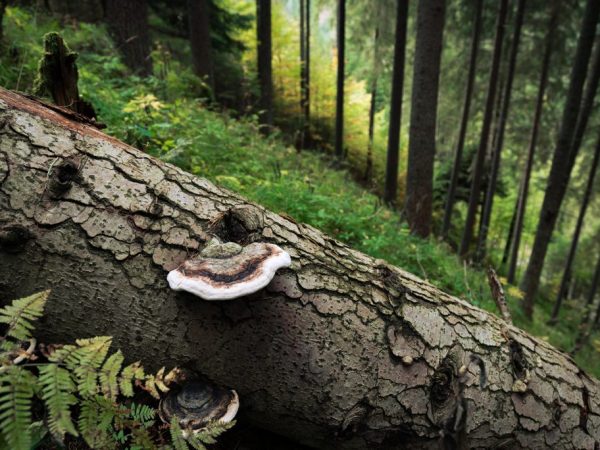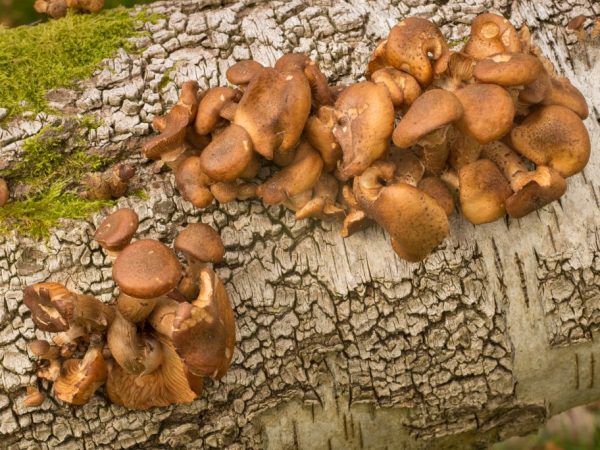Destroyer mushrooms
Such a phenomenon as the circulation of substances in nature, or rather in the biosphere, is an integral part of life on the planet. All living organisms go through 5 stages of life: birth, maturation, reproduction, aging and death. After death, any body begins to decompose. And this becomes an object of nutrition for some representatives of fungal species. That is why they got the name “mushroom destroyers”.

Destroyers mushrooms
The role of mushrooms in the food chain
Any food chain in nature, which is called the "graze chain" ends with fungi and microorganisms such as bacteria, that is, with decomposers. Plants are usually found at the beginning of this food chain, form nutrients during photosynthesis and are food for many insects, rodents, birds and parts of large animals. This group is called herbivores, or 1st order consumers. All these living creatures, on their part, serve as food for consumers (consumers) of the 2nd and 3rd orders, that is, predators. And many animals, birds, insects, marine life and elements of vegetation are eaten by humans.
But all living things, including people, die as a result and become a "food kit" of organic compounds for fungi and bacteria. They feed on dead organisms and decompose them into simple initial constituents - inorganic compounds. Therefore, fungi and bacteria are called destroyers, or decomposers. They play an important role in the food chain because they dispose of the dead remains of vegetation, animals and people. Trace elements that remain from dead organisms after the vital activity of fungi and bacteria are the basis for the growth of new vegetation, and the cycle of substances begins anew. With these same fungi and bacteria begins another type of food chain "detrital", or "decomposition chain".
Destructive fungi and bacteria act as natural sewers.
Types of mushrooms
Depending on the method of nutrition, all representatives of the mushroom culture are divided into 3 types:
- saprophytes;
- parasites;
- symbiotics (those that create mycorrhizal symbiosis).
Irina Selyutina (Biologist):
The following ecological groups of destroying fungi (mainly macromycetes) can be distinguished by food source:
- Saprophytes (saprotrophs): food source dead organics (litter and humus). Attention! Not to be confused with saprophages. This term refers to animals.
- Xylotrophs: wood destroyers, which can be both parasites and saprophytes.
- Coprotrophs: the source of organic matter is animal excrement.
- Bryotrophs: the source of nutrients is the dead parts of mosses.
- Mycotrophs, or saprotrophic mycophils: representatives of the group develop on mummified fruiting bodies of cap mushrooms.
To cleanse the planet of the dead remains of animals and plants, these representatives of the mushroom kingdom must exist in large quantities in all corners of the Earth where there is life.
Saprophytes
Saprophytes are not only fungal representatives, but also any organisms that feed on organic compounds of dead plants and animals. Many species of large fungi belong to this group of organisms. In addition to the remains of living beings, they extract nutrients from humus, fallen leaves, straw, trunks and branches of various trees, stumps and charcoal.
Biologists additionally divide saprophytes into 2 groups:
- The first includes those representatives who have chosen plant and animal waste and waste products as their habitat - leaves, manure, feathers, etc.
- The second group includes bacteria that can inhabit almost all organisms and substances. By their vital activity, they contribute to the decay of the bodies of organisms and their breakdown into microelements and in this way help the formation and accumulation of nitrogen in the soil.
Saprophytes are very useful organisms, because thanks to the decomposition of the remains of animals and plants into microelements, a resource is formed for the formation of a new organism.
Parasitic fungi

Honey mushrooms eventually destroy the tree
There are representatives of fungi that lead a parasitic lifestyle, that is, they live on living organisms and feed on them. They suck a large amount of nutrients from their hosts. In doing so, they harm them, destroy their internal structure or completely destroy them.
There are almost 2000 species of such parasites in the Kingdom of Fungi. These include some mushrooms (autumn honey mushrooms), ergot, smut, rusty, tinder fungus and many others. Some parasitic fungi live on other fungi. An example is the flywheel, which parasitizes on an ordinary raincoat, or volvariel, which usually lives on talkers.
There are also predatory fungi that feed on insects.
Mycorrhizal symbiosis
Mycorrhiza is a mutually beneficial symbiosis of green plants and fungi, often referred to as a “community of life”. At the same time, the mycelium of fungi combines with the roots of higher plants, even with the smallest ones, and in this way receives from them all the nutrients necessary for their own life. Some destroying fungi are able to penetrate the roots, but neither this nor the other way of their existence does harm to plants, but on the contrary - benefits. Indeed, thanks to myceliums, they have quick access to the minerals contained in the soil.
Irina Selyutina (Biologist):
In the literature, there are 3 types of mycorrhiza, which differ in structural features:
- Ectotrophic: fungal hyphae braid the root surface, forming a kind of cover. Hyphae penetrate the root bark and spread through the intercellular spaces without entering the cells.
- Endomycorrhiza: hyphae penetrate the cells of the root cortex through the pores. On the root surface, mycorrhiza is poorly visible. This means that the bulk of the hyphae is inside the root.
- Ectoendomycorrhiza: is an intermediate option between the first and second type.
A good example of mycorrhizal symbiosis is the association of fungi and conifers. Certain representatives of fungal species are located on the roots of pine trees. Only when they are present do trees grow tall and strong. Lichens are prominent representatives of symbiotic bodies. They are formed from the thallus of the mycobiont (fungus) and the cells of the phytobiont (microscopic green algae). There are more than 26 thousand varieties of lichens.
Features of mushrooms
All representatives of mushrooms, as well as representatives of the kingdom of flora - vegetation, grow constantly. They have similarities with the animal world - like animals, they feed on ready-made organic substances. They can grow both in fields - on grain crops, and in forests - on any wood, as well as on the soil surface, on spoiled products, etc.In any area of their habitat, they process organic matter, so different types of fungi and bacteria are called destroyers.
The fungal body - mycelium, or mycelium, or vegetative body - consists of many cells that outwardly look like thin long threads. Mycelium cells absorb solutes, they help to play the role of destroyers. Fruit bodies grow on the mycelium, spores ripen in them, thanks to which reproduction occurs.
Conclusion
Fungi and bacteria are innate destroyers that, during their life, cleanse the planet from the accumulation of dead bodies of animals and plants, decomposing their organic remains and turning them into nutrients. They participate in the food chain, their activities help maintain the continuity of life on Earth. Among all the varieties of fungi and bacteria, some are beneficial, while others are only harm and damage.



